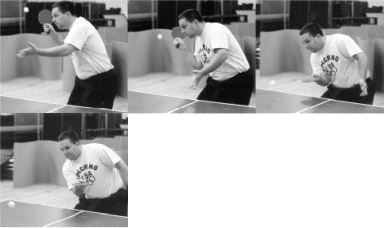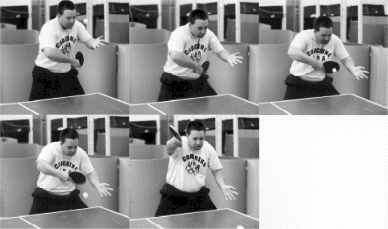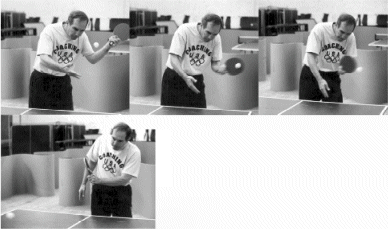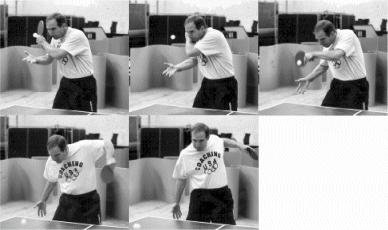TEACHING SIMPLE SERVES
To start with, you should teach your students to
serve topspin and backspin, with both the backhand
and forehand. These four serves will not only
be useful in games but will also allow them to
serve in such a way as to start good rallies during
practice.
Make sure you have explained the difference
between topspin and backspin before teaching these
serves. Also make sure they understand the service
rules.
Once demonstrated, the kids should be sent out on
the table to practice their serves. They should
not rally at this time. Have one serve the ball and
the other catch it and serve it back. Give them goals
to work towards, either a certain number of good
serves in a row or a specific target on the table
to hit a certain number of times.
Some children will have trouble doing a six-inch
toss and making a good serve. For these players,
you can help by guiding their playing arms through
the stroke. You should still let them do the toss
alone, however.
To teach a topspin serve, have them hold the
racquet so it is perpendicular to the floor. Have them
contact the ball on the back towards the top with an
upward and forward motion. Show them how to
graze the ball for maximum topspin. This serve
can be done either forehand or backhand, whichever
is easier for the child. However, they should
eventually learn to do it both forehand and
backhand.
A topspin serve, once learned, can be served very
fast. Players should see how fast they can serve
the ball and still keep it on the table. For
maximum speed, do not graze the ball too much. Have
the ball sink mostly into the wood and swing
mostly straight forward. Try to have the ball hit the
table as close to the endline on the far side as
possible. If it lands too short, the serve can be served
faster. If it lands too deep, it’s been served off the
end.
To teach a backspin serve, have him/her hold the
racquet so the hitting surface is pointing mostly
upward at about a 45 degree angle to the floor.
The specific angle depends both on the type of racquet
surface, the speed of the racquet at contact, and
how finely the ball is grazed. This is true on all
serves, but especially with backspin and sidespin.
Contact the ball on the back towards the bottom
with a downward stroke. Again, stress that the
more you graze the ball, the more spin. This serve can
also be done both forehand and backhand, and both
ways should be learned.
On all serves, the points that should be stressed
are:
-
Keep the ball low.
-
All serves should be served with as much spin or as much speed as
possible.
-
All serves should be aimed at a particular part of the table, not
just served in the general direction of the far side.
-
Serve with a general plan in mind. If you want a topspin return,
serve topspin. If you want a backspin return, serve backspin. Of
course, this is just a generality. You can’t force your opponent
to return the ball the way you want. But you can try.
-
Make sure the serve is legal!
Below, you will find sequences
of the forehand and backhand topspin, backspin
and sidespin serves.

Forehand Topspin Serve

Forehand Backspin Serve

Backhand Topspin Serve

Backhand Backspin Serve

Forehand Sidespin Serve

Backhand Sidespin Serve
Similar to backhand
backspin or topspin serve except racket moves sideways instead of down or up.
Copyright Larry Hodges
Copyright
Mark Nordby, Dan Seemiller, John Oros
Copyright USA Table Tennis
|